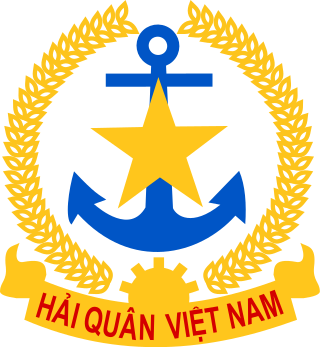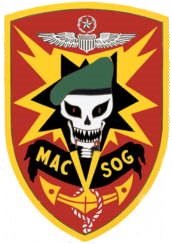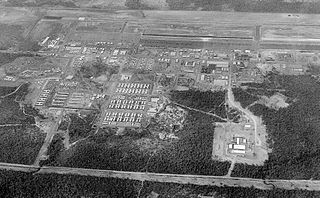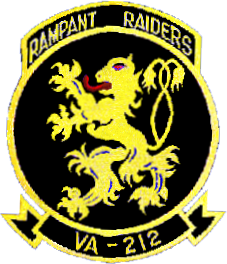
The People's Army of Vietnam (PAVN), officially the Vietnam People's Army, also recognized as the Vietnamese Army or the People's Army, is the military force of the Socialist Republic of Vietnam and the armed wing of the ruling Communist Party of Vietnam (CPV). The PAVN is a part of the Vietnam People's Armed Forces and includes: Ground Force, Navy, Air Force, Border Guard and Coast Guard. Vietnam does not have a separate Ground Force or Army service. All ground troops, army corps, military districts and special forces belong to the Ministry of National Defence, directly under the command of the CPV Central Military Commission, the Minister of National Defence, and the General Staff of the Vietnam People's Army. The military flag of the PAVN is the National flag of the Socialist Republic of Vietnam defaced with the motto Quyết thắng added in yellow at the top left.

Võ Nguyên Giáp was a militarily self-taught general of the People's Army of Vietnam (PAVN), communist revolutionary and politician. Regarded as one of the greatest military strategists of the 20th century, Giáp commanded Vietnamese communist forces in various wars. He served as the military commander of the Việt Minh and later the PAVN from 1941 to 1972, as the minister of defence of the Democratic Republic of Vietnam and later Socialist Republic of Vietnam in 1946–1947 and from 1948 to 1980, and as deputy prime minister from 1955 to 1991. He was also a member of the Politburo of the Communist Party of Vietnam.

The Ho Chi Minh Trail, also called Annamite Range Trail was a logistical network of roads and trails that ran from North Vietnam to South Vietnam through the kingdoms of Laos and Cambodia. The system provided support, in the form of manpower and materiel, to the Viet Cong and the People's Army of Vietnam (PAVN), during the Vietnam War. Construction for the network began following the North Vietnamese invasion of Laos in July 1959.

The Laotian Civil War (1959–1975) was a civil war in Laos waged between the Communist Pathet Lao and the Royal Lao Government from 23 May 1959 to 2 December 1975. It is associated with the Cambodian Civil War and the Vietnam War, with both sides receiving heavy external support in a proxy war between the global Cold War superpowers. It is called the Secret War among the American CIA Special Activities Center, and Hmong and Mien veterans of the conflict.

The Lockheed P-2 Neptune is a maritime patrol and anti-submarine warfare (ASW) aircraft. It was developed for the US Navy by Lockheed to replace the Lockheed PV-1 Ventura and PV-2 Harpoon, and was replaced in turn by the Lockheed P-3 Orion. Designed as a land-based aircraft, the Neptune never made a carrier landing, but a small number were converted and deployed as carrier-launched, stop-gap nuclear bombers that would have to land on shore or ditch. The type was successful in export, and saw service with several armed forces.

Operation Commando Hunt was a covert U.S. Seventh Air Force and U.S. Navy Task Force 77 aerial interdiction campaign that took place during the Vietnam War. The operation began on 15 November 1968 and ended on 29 March 1972. The objective of the campaign was to prevent the transit of People's Army of Vietnam (PAVN) personnel and supplies on the logistical corridor known as the Ho Chi Minh Trail that ran from the southwestern Democratic Republic of Vietnam through the southeastern portion of the Kingdom of Laos and into the Republic of Vietnam.
Operation Igloo White was a covert United States joint military electronic warfare operation conducted from late January 1968 until February 1973, during the Vietnam War. These missions were carried out by the 553d Reconnaissance Wing, a U.S. Air Force unit flying modified EC-121R Warning Star aircraft, and VO-67, a specialized U.S. Navy unit flying highly modified OP-2E Neptune aircraft. This state-of-the-art operation utilized electronic sensors, computers, and communications relay aircraft in an attempt to automate intelligence collection. The system would then assist in the direction of strike aircraft to their targets. The objective of those attacks was the logistical system of the People's Army of Vietnam (PAVN) that snaked through southeastern Laos and was known as the Ho Chi Minh Trail.

The Vietnam People's Navy, internally the Naval Service, also known as the Vietnamese People's Navy or simply Vietnam/Vietnamese Navy, is the naval branch of the Vietnam People's Army and is responsible for the protection of the country's national waters, islands, and interests of the maritime economy, as well as for the co-ordination of maritime police, customs service and the border defence force.

Military Assistance Command, Vietnam – Studies and Observations Group (MACV-SOG) was a highly classified, multi-service United States special operations unit which conducted covert unconventional warfare operations before and during the Vietnam War.
Group 559 was a transportation and logistical unit of the People's Army of Vietnam. Established on 19 May 1959 to move troops, weapons, and materiel from North Vietnam to Vietcong paramilitary units in South Vietnam, the unit created and maintained the Ho Chi Minh Trail, the supply line that helped the North win the Vietnam War.

The Nakhon Phanom Royal Thai Navy Base (NKP), formerly Nakhon Phanom Royal Thai Air Force Base, is a Royal Thai Navy facility used for riverine patrols along the Mekong River. It is approximately 587 km (365 mi) northeast of Bangkok, 14.5 km (9.0 mi) west of Nakhon Phanom city in Nakhon Phanom Province in the northeastern region of Thailand, and 411 km (255 mi) from Hanoi in Vietnam. The Mekong River is NKP's border with Laos. The airfield at NKP is jointly used as a civilian airport.
Ubon Royal Thai Air Force Base is a Royal Thai Air Force (RTAF) facility located near the city of Ubon Ratchathani, in Ubon Ratchathani Province. It is approximately 488 km northeast of Bangkok. The Laos border is about 60 kilometres (37 mi) directly east. The facility is also used as a civil airport.

Operation Steel Tiger was a covert U.S. 2nd Air Division, later Seventh Air Force and U.S. Navy Task Force 77 aerial interdiction effort targeted against the infiltration of People's Army of Vietnam (PAVN) men and material moving south from the Democratic Republic of Vietnam through southeastern Laos to support their military effort in the Republic of Vietnam during the Vietnam War.

Operation Tiger Hound was a covert U.S. 2nd Air Division, later Seventh Air Force and U.S. Navy Task Force 77 aerial interdiction campaign conducted in southeastern Laos from 5 December 1965 till 11 November 1968, during the Vietnam War. The purpose of the operation was to interdict the flow of People's Army of Vietnam (PAVN) supplies on the Ho Chi Minh Trail from the Democratic Republic of Vietnam, through southeastern Laos, and into the northern provinces of the Republic of Vietnam. The missions were originally controlled by the 2d Air Division until that headquarters was superseded by the Seventh Air Force on 1 April 1966.

Operation Barrel Roll was a covert U.S. Air Force 2nd Air Division and U.S. Navy Task Force 77, interdiction and close air support campaign conducted in the Kingdom of Laos between 14 December 1964 and 29 March 1973 concurrent with the Vietnam War. The operation resulted in 260 million bombs being dropped on Laos.

Operation Niagara was a U.S. Seventh Air Force close air support campaign carried out from January through March 1968, during the Vietnam War. Its purpose was to serve as an aerial umbrella for the defense of the U.S. Marine Corps Khe Sanh Combat Base on the Khe Sanh Plateau, in western Quang Tri Province of the Republic of Vietnam. The base was under siege by an estimated three-divisional force of the People's Army of Vietnam (PAVN).

Đồng Sĩ Nguyên, also spelled Đồng Sỹ Nguyên, other name Nguyễn Hữu Vũ, was a Vietnamese soldier and politician. He was Deputy Prime Minister of Vietnam, a member of the Politburo of the Communist Party of Vietnam, lieutenant-general of the North Vietnamese Army, and minister of transport of Vietnam. He was born in Quảng Bình Province, home to general Võ Nguyên Giáp and Ngô Đình Diệm, president of the Republic of Vietnam.

Forward air controllers (FACs) played a significant part in the Vietnam War from the very start. Largely relegated to airborne duty by the constraints of jungled terrain, FACs began operations as early as 1962. Using makeshift propeller-driven aircraft and inadequate radio nets, they became so essential to air operations that the overall need for FACs would not be completely satisfied until 1969. The FAC's expertise as an air strike controller also made him an intelligence source, munitions expert, communication specialist, and above all, the on-scene commander of the strike forces and the start of any subsequent combat search and rescue if necessary.

Attack Squadron 212 (VA-212), nicknamed the Rampant Raiders, was an aviation unit of the United States Navy. It was established as Fighter Squadron 212 (VF-212) on 20 June 1955, and redesignated as VA-212 on 1 April 1956. The squadron was disestablished on 12 December 1975.
Operation Left Jab was the first military offensive launched against the Sihanouk Trail extension of the Ho Chi Minh Trail during the Second Indochina War. It was the first battalion-sized operation waged by the Royal Lao Army against the communists in Military Region 4. Carried out between 21 and 26 June 1969, the assault interdicted Route 110 of the Sihanouk Trail for its planned three-day stoppage of military supplies. The Royalist guerrillas of Special Guerrilla Unit 2 then evaded an approaching counterattack and regrouped in friendly territory. Operation Left Jab had cleared the way for Operation Diamond Arrow.
















